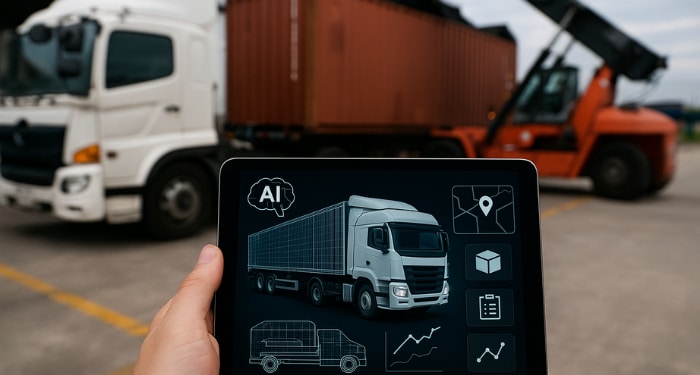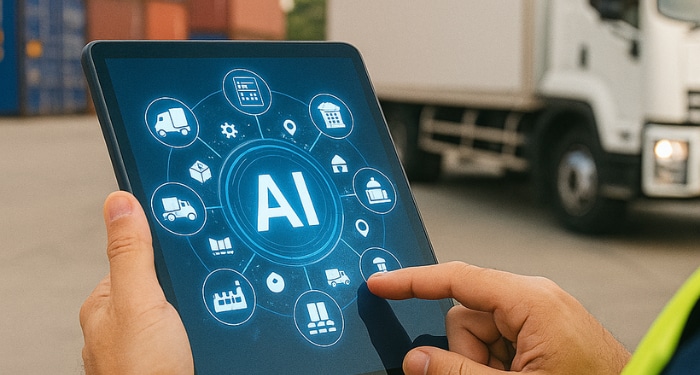Artificial Intelligence is no longer a futuristic buzzword. In the world of transport and logistics, it has become a real and measurable tool for improving how goods move, how warehouses operate, and how customers are served. From predicting delays to optimizing delivery routes, AI in logistics is quietly making supply chains faster, smarter, and more resilient.

Table of Contents
Key Moments When AI in Logistics Intervenes in the Supply Chain
AI steps in at key decision points to assist, predict, or automate tasks. These are some of the most common moments where AI actively contributes:
| Logistics Stage | How AI Contributes |
| Order Planning | Forecasts demand and groups orders smartly |
| Dispatch and Routing | Plans optimal routes in real time |
| In-Transit Monitoring | Predicts delays using traffic and weather data |
| Warehouse Operations | Optimizes storage, picking, and task allocation |
| Customer Communication | Sends real-time updates and delivery alerts |
| After Delivery / Returns | Analyzes feedback and identifies return issues |
| Inventory Management | Predicts stock levels and automates reordering |
| Pricing and Quotation | Adjusts prices based on data and capacity |
| Customs and Documentation | Automates paperwork |

How to Use AI in Logistics (Even Without a Tech Team)
You do not need a dedicated AI department to get started. Here are three simple and effective ways to use AI in logistics today:
- Choose Smart Logistics Software: Many transportation and warehouse management systems now include built-in AI features. These include automated shipment planning, dynamic pricing, and real-time performance monitoring.
- Use AI Tools Through APIs: Smaller logistics providers can use API-based tools to enhance existing systems. These tools help with functions like automated document reading, load optimization, and route planning, without requiring a full platform change.
- Develop Custom AI Solutions: Larger companies often work with data scientists or specialized partners to build AI models tailored to their operations. These solutions can support emissions tracking, shipment optimization, or supply chain risk analysis.
The Key Advantages of AI in Logistics
1. Real-Time Route Optimization
AI systems can analyze live traffic, weather conditions, vehicle capacity, and customer delivery windows. They use this data to find the most efficient routes in real time. This leads to shorter delivery times, reduced fuel consumption, and better on-time performance. Companies using AI for routing have seen delivery costs drop by up to 20 percent.
2. Accurate Demand Forecasting
By processing historical data along with seasonal patterns and market signals, AI can forecast demand with remarkable accuracy. This helps companies prepare for high and low seasons, reducing waste and improving customer satisfaction.
3. Smarter Warehouse Operations
In modern distribution centers, AI helps manage robotic systems, track inventory movements, and optimize picking and storage strategies. As a result, warehouses become more productive, scalable, and responsive to order spikes.
4. Predictive Maintenance
AI-powered sensors monitor the condition of trucks and equipment, detecting early signs of malfunction. Maintenance can then be scheduled before failures occur, reducing downtime and extending the life of valuable assets.
5. AI-Enhanced Customer Service
Natural language processing and AI chatbots are already handling shipment tracking inquiries, estimated time of arrival updates, and order status questions. These tools support customers 24/7 and allow human agents to focus on more complex tasks.

What Makes AI Adoption Successful?
Successful adoption of AI in logistics is not about replacing people, it’s about empowering teams with intelligent tools that enhance decision-making and operational agility. When implemented thoughtfully, AI acts as an extension of human capability, helping logistics professionals manage complexity with speed and precision. For example, planners can instantly simulate different routing scenarios, warehouse managers can spot inefficiencies before they escalate, and customer service teams can access live shipment updates without manual input.
The companies that benefit most from AI are those that view it as a strategic asset rather than just a tech upgrade. They invest in high-quality, clean data as the foundation of any AI initiative, ensuring that predictions and automations are reliable. They also prioritize flexibility; choosing platforms and tools that adapt to their unique processes rather than forcing standardized workflows. Most importantly, they strike the right balance between automation and human oversight, using AI to remove bottlenecks while keeping people in control of critical exceptions and customer relationships.
How AI Supports Our Day-to-Day Operations
At Portex, artificial intelligence plays a key role in enhancing our logistics capabilities across transport, warehousing, and freight forwarding. In transport operations, artificial intelligence supports real-time planning and order management by automatically adjusting routes, schedules, and vehicle assignments based on live traffic data and available capacity. This helps us reduce delays and improve delivery accuracy.
Within our warehouses, it contributes to better space utilization, real-time inventory tracking, and the coordination of cross-docking flows with full scanning support and predictive stock alerts. In freight forwarding, intelligent systems assist with selecting the most suitable carriers, handling documentation seamlessly, and generating accurate quotes based on historical trends and current market conditions. These applications allow us to operate with greater speed, precision, and visibility, while keeping our clients informed at every stage of the supply chain.
If you’re curious about how we apply artificial intelligence to improve service and efficiency, feel free to contact our team. We’re always happy to explore how smart logistics solutions can support your business.

